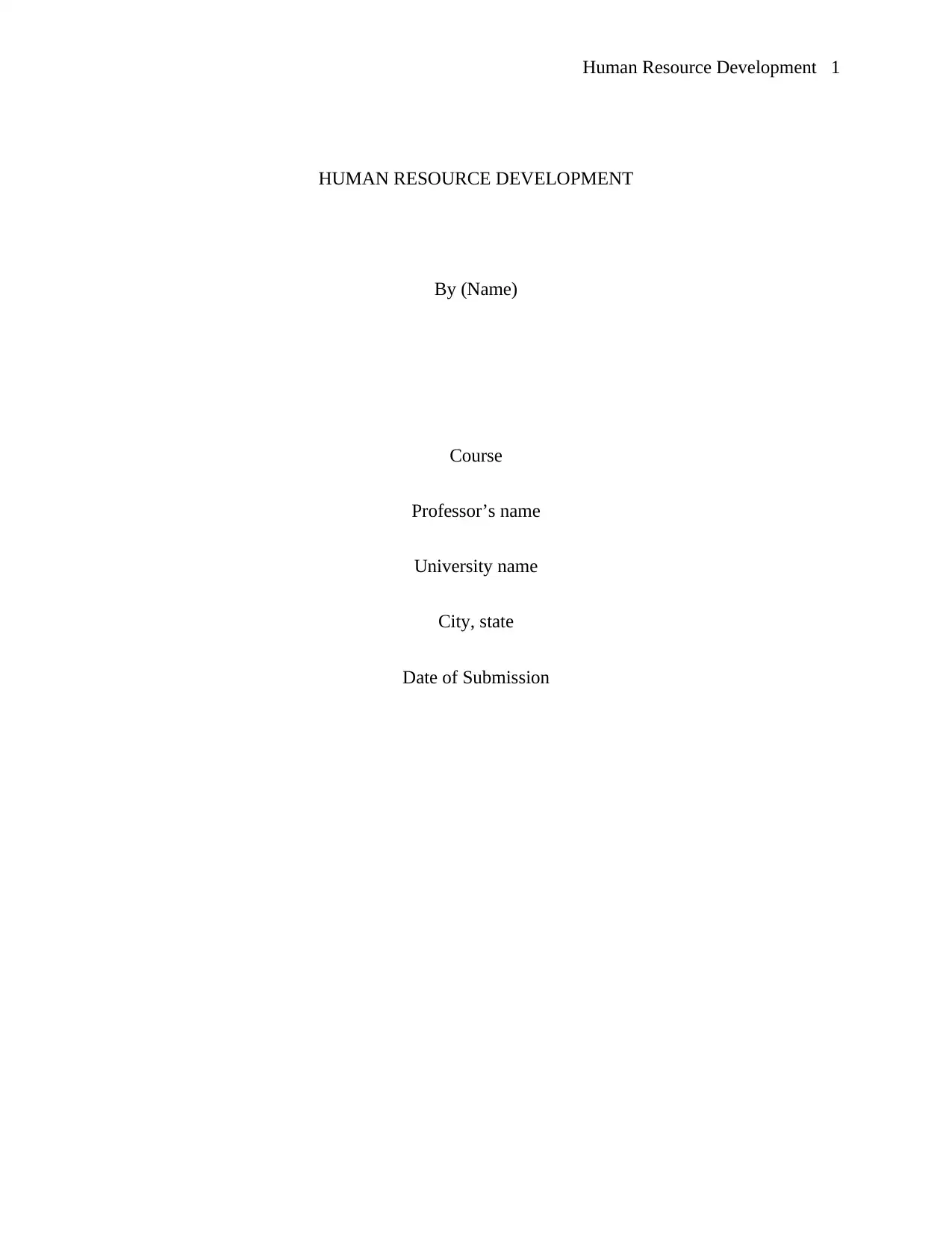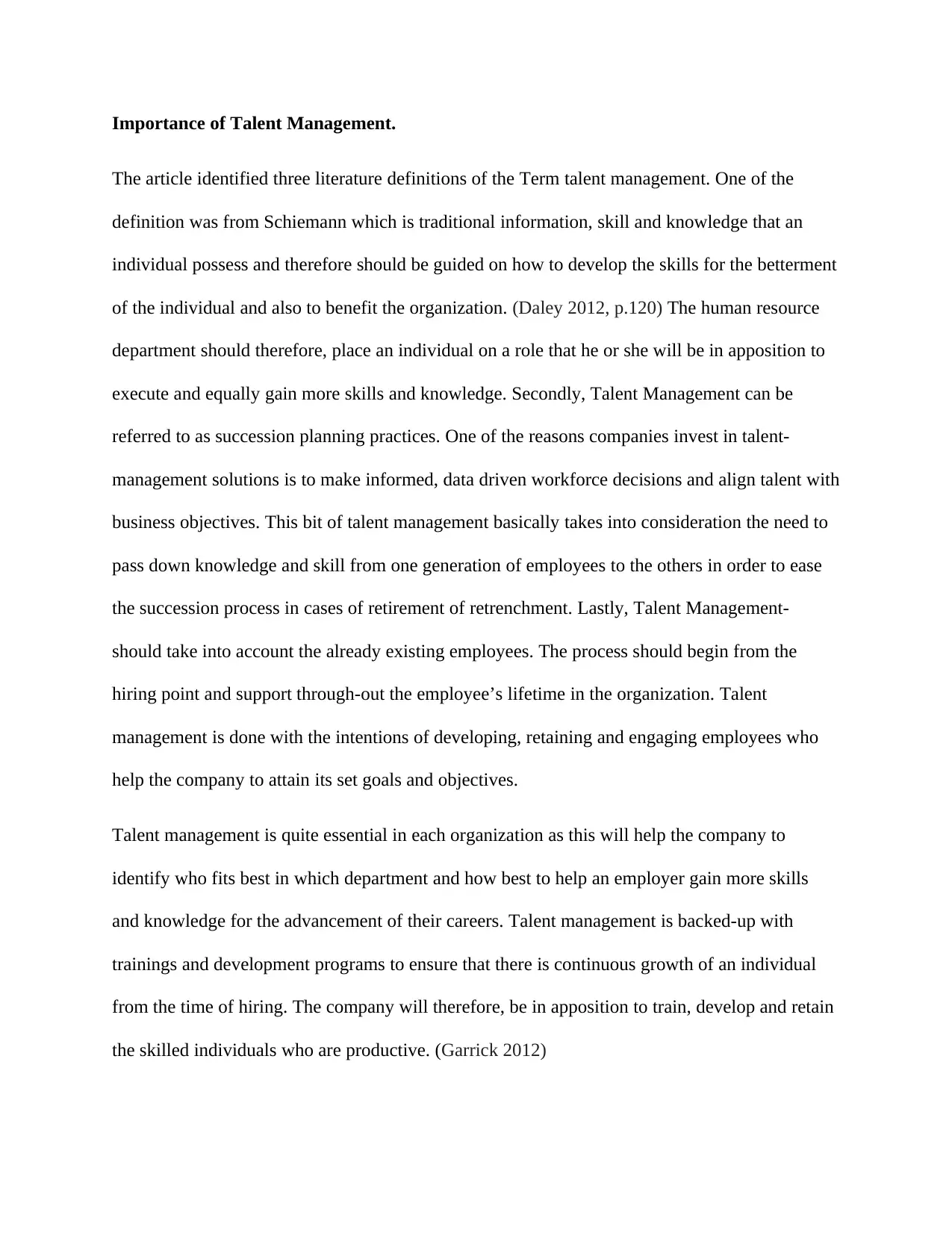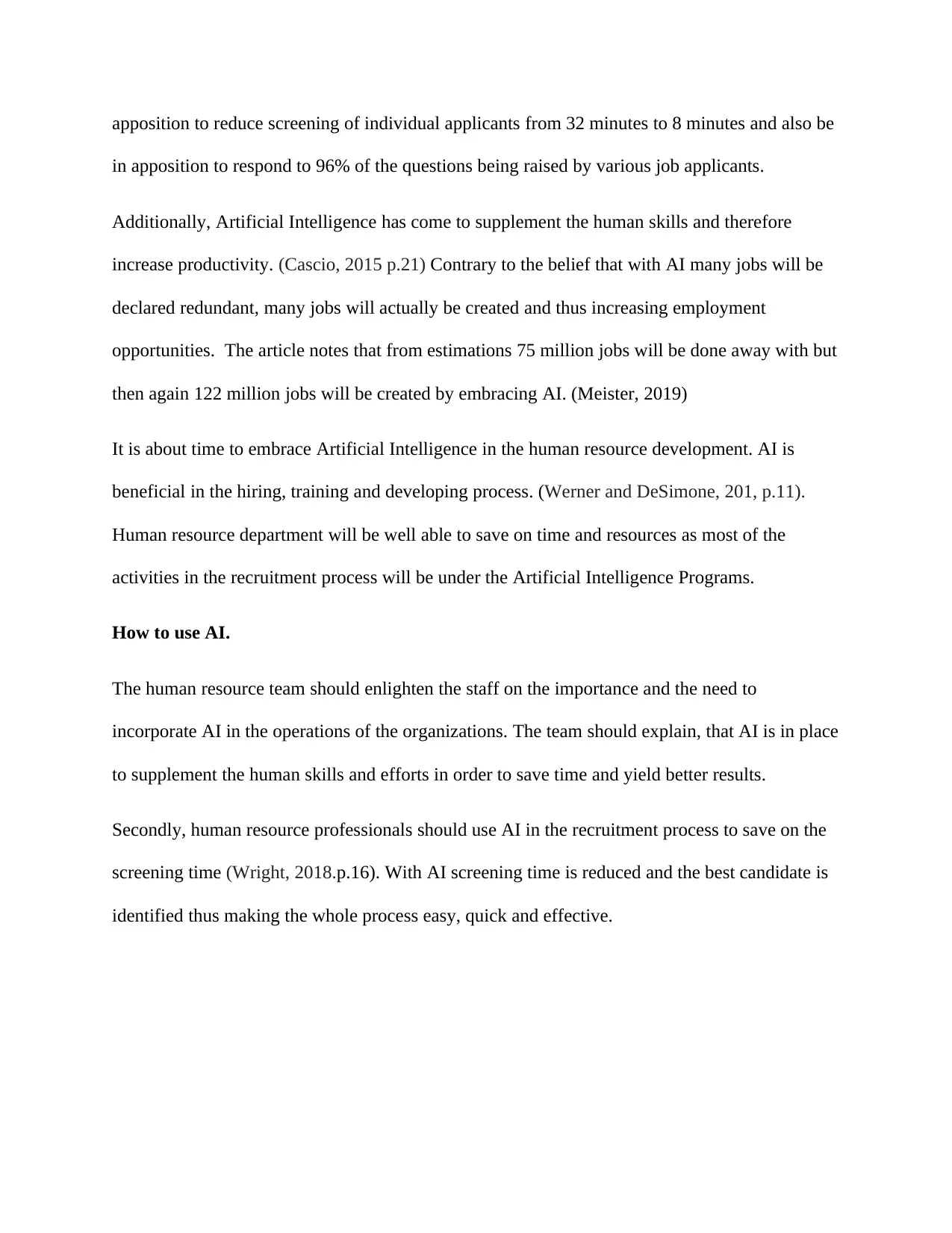University HR Development Report: Talent Management and AI Trends
VerifiedAdded on 2023/01/16
|6
|1358
|47
Report
AI Summary
This report analyzes key trends in Human Resource Development, focusing on talent management and the integration of Artificial Intelligence (AI). The report begins by defining talent management and its importance, highlighting the need to hire employees based on their abilities and develop their skills. It explores different definitions of talent management, including succession planning and employee engagement, and emphasizes the role of the HR department in implementing effective talent management processes. The report then delves into the impact of AI on HR, discussing its benefits in recruitment, training, and development, and addressing concerns about job displacement. The author cites examples of organizations like Hilton and DBS Bank that have successfully incorporated AI into their HR departments, improving efficiency and productivity. The report concludes by emphasizing the importance of embracing AI in HR and providing recommendations on how to integrate it effectively, including staff training and strategic use of AI in recruitment. The report draws on various sources to support its findings, providing a comprehensive overview of current trends and best practices in HR.

Human Resource Development 1
HUMAN RESOURCE DEVELOPMENT
By (Name)
Course
Professor’s name
University name
City, state
Date of Submission
HUMAN RESOURCE DEVELOPMENT
By (Name)
Course
Professor’s name
University name
City, state
Date of Submission
Paraphrase This Document
Need a fresh take? Get an instant paraphrase of this document with our AI Paraphraser

Memorandum
Date:
To:
From:
Subject: Human Resource Development.
1. Talent Management: Hiring and Developing Engaged Employees by Chuck O’Bryan and
Anne Marie Casey.
2. Ten HR.Trends in The Age of Artificial Intelligence By Jeanne Meister.
Talent Management: Hiring and Developing Engaged Employees.
Human resource is one of the essential parts of an organization and therefore calls for proper
mechanisms in the management process in order to reap from the input of the employees. Over
the years, the human resource development scene has evolved with a few trending topics
emerging on how best to manage the field. (Wright 2018, p.15). Among the trending topics is
talent management, improving leadership management and employee’s management.
This article addressed the need to hire employees in relation to their abilities and in turn seek to
improve their skills while at the work place. According to Schiemann “talent is the collective
knowledge, skills, abilities, experiences, values habits and behaviors that is brought to bear on
the organizations mission”. The article consequently delves into the need to have proper
leadership development in the organization and lastly encourage employee engagement in the
activities of the organization.
Date:
To:
From:
Subject: Human Resource Development.
1. Talent Management: Hiring and Developing Engaged Employees by Chuck O’Bryan and
Anne Marie Casey.
2. Ten HR.Trends in The Age of Artificial Intelligence By Jeanne Meister.
Talent Management: Hiring and Developing Engaged Employees.
Human resource is one of the essential parts of an organization and therefore calls for proper
mechanisms in the management process in order to reap from the input of the employees. Over
the years, the human resource development scene has evolved with a few trending topics
emerging on how best to manage the field. (Wright 2018, p.15). Among the trending topics is
talent management, improving leadership management and employee’s management.
This article addressed the need to hire employees in relation to their abilities and in turn seek to
improve their skills while at the work place. According to Schiemann “talent is the collective
knowledge, skills, abilities, experiences, values habits and behaviors that is brought to bear on
the organizations mission”. The article consequently delves into the need to have proper
leadership development in the organization and lastly encourage employee engagement in the
activities of the organization.

Importance of Talent Management.
The article identified three literature definitions of the Term talent management. One of the
definition was from Schiemann which is traditional information, skill and knowledge that an
individual possess and therefore should be guided on how to develop the skills for the betterment
of the individual and also to benefit the organization. (Daley 2012, p.120) The human resource
department should therefore, place an individual on a role that he or she will be in apposition to
execute and equally gain more skills and knowledge. Secondly, Talent Management can be
referred to as succession planning practices. One of the reasons companies invest in talent-
management solutions is to make informed, data driven workforce decisions and align talent with
business objectives. This bit of talent management basically takes into consideration the need to
pass down knowledge and skill from one generation of employees to the others in order to ease
the succession process in cases of retirement of retrenchment. Lastly, Talent Management-
should take into account the already existing employees. The process should begin from the
hiring point and support through-out the employee’s lifetime in the organization. Talent
management is done with the intentions of developing, retaining and engaging employees who
help the company to attain its set goals and objectives.
Talent management is quite essential in each organization as this will help the company to
identify who fits best in which department and how best to help an employer gain more skills
and knowledge for the advancement of their careers. Talent management is backed-up with
trainings and development programs to ensure that there is continuous growth of an individual
from the time of hiring. The company will therefore, be in apposition to train, develop and retain
the skilled individuals who are productive. (Garrick 2012)
The article identified three literature definitions of the Term talent management. One of the
definition was from Schiemann which is traditional information, skill and knowledge that an
individual possess and therefore should be guided on how to develop the skills for the betterment
of the individual and also to benefit the organization. (Daley 2012, p.120) The human resource
department should therefore, place an individual on a role that he or she will be in apposition to
execute and equally gain more skills and knowledge. Secondly, Talent Management can be
referred to as succession planning practices. One of the reasons companies invest in talent-
management solutions is to make informed, data driven workforce decisions and align talent with
business objectives. This bit of talent management basically takes into consideration the need to
pass down knowledge and skill from one generation of employees to the others in order to ease
the succession process in cases of retirement of retrenchment. Lastly, Talent Management-
should take into account the already existing employees. The process should begin from the
hiring point and support through-out the employee’s lifetime in the organization. Talent
management is done with the intentions of developing, retaining and engaging employees who
help the company to attain its set goals and objectives.
Talent management is quite essential in each organization as this will help the company to
identify who fits best in which department and how best to help an employer gain more skills
and knowledge for the advancement of their careers. Talent management is backed-up with
trainings and development programs to ensure that there is continuous growth of an individual
from the time of hiring. The company will therefore, be in apposition to train, develop and retain
the skilled individuals who are productive. (Garrick 2012)
⊘ This is a preview!⊘
Do you want full access?
Subscribe today to unlock all pages.

Trusted by 1+ million students worldwide

What should be done?
The Human resource department should therefore, adopt a mechanism that will help in talent
management process in the organization. In an article done by Evans and Chum, the 2012 ASEH
Higher Education Report a framework for strategic talent management in higher education is laid
out with focus on four important areas which are; recruitment, outreach and hiring, affirmative
action and diversity, total rewards and employee engagement.
Additionally, the human resource team should ensure annual allocation of funds in the budget for
the purposes of staff training and development programs. The programs should focus on
motivating factors for the employees in order to keep them more engaged in the organization
(Barrat 2013). More so, the trainings should help in passing of knowledge and skills to ensure
ease in the succession process.
Ten HR. Trends in the Age of Artificial Intelligence by Jeanne Meister.
The article by Jeanne Meister addresses the changes brought about in the human resource field as
a result of the innovations made in technology which has introduced Artificial intelligence. The
article obtained reports from various organizations that have since incorporated Artificial
intelligence in their Human resource department such as Hilton and DBS bank (Noe et al. 2017).
Importance of Artificial Intelligence in Human Resource Development.
From the article it is evident that artificial Intelligence is an idea that is here to stay and should
be embraced by organizations due to the benefits it has especially in ease of work. Through
Artificial Intelligence it is easier to identify the best candidate for a particular job by simply
posing relevant questions through the screening process. (Garrick, 2012). The help of AI DBS
bank has made tremendous improvements in the hiring process. The company has been in
The Human resource department should therefore, adopt a mechanism that will help in talent
management process in the organization. In an article done by Evans and Chum, the 2012 ASEH
Higher Education Report a framework for strategic talent management in higher education is laid
out with focus on four important areas which are; recruitment, outreach and hiring, affirmative
action and diversity, total rewards and employee engagement.
Additionally, the human resource team should ensure annual allocation of funds in the budget for
the purposes of staff training and development programs. The programs should focus on
motivating factors for the employees in order to keep them more engaged in the organization
(Barrat 2013). More so, the trainings should help in passing of knowledge and skills to ensure
ease in the succession process.
Ten HR. Trends in the Age of Artificial Intelligence by Jeanne Meister.
The article by Jeanne Meister addresses the changes brought about in the human resource field as
a result of the innovations made in technology which has introduced Artificial intelligence. The
article obtained reports from various organizations that have since incorporated Artificial
intelligence in their Human resource department such as Hilton and DBS bank (Noe et al. 2017).
Importance of Artificial Intelligence in Human Resource Development.
From the article it is evident that artificial Intelligence is an idea that is here to stay and should
be embraced by organizations due to the benefits it has especially in ease of work. Through
Artificial Intelligence it is easier to identify the best candidate for a particular job by simply
posing relevant questions through the screening process. (Garrick, 2012). The help of AI DBS
bank has made tremendous improvements in the hiring process. The company has been in
Paraphrase This Document
Need a fresh take? Get an instant paraphrase of this document with our AI Paraphraser

apposition to reduce screening of individual applicants from 32 minutes to 8 minutes and also be
in apposition to respond to 96% of the questions being raised by various job applicants.
Additionally, Artificial Intelligence has come to supplement the human skills and therefore
increase productivity. (Cascio, 2015 p.21) Contrary to the belief that with AI many jobs will be
declared redundant, many jobs will actually be created and thus increasing employment
opportunities. The article notes that from estimations 75 million jobs will be done away with but
then again 122 million jobs will be created by embracing AI. (Meister, 2019)
It is about time to embrace Artificial Intelligence in the human resource development. AI is
beneficial in the hiring, training and developing process. (Werner and DeSimone, 201, p.11).
Human resource department will be well able to save on time and resources as most of the
activities in the recruitment process will be under the Artificial Intelligence Programs.
How to use AI.
The human resource team should enlighten the staff on the importance and the need to
incorporate AI in the operations of the organizations. The team should explain, that AI is in place
to supplement the human skills and efforts in order to save time and yield better results.
Secondly, human resource professionals should use AI in the recruitment process to save on the
screening time (Wright, 2018.p.16). With AI screening time is reduced and the best candidate is
identified thus making the whole process easy, quick and effective.
in apposition to respond to 96% of the questions being raised by various job applicants.
Additionally, Artificial Intelligence has come to supplement the human skills and therefore
increase productivity. (Cascio, 2015 p.21) Contrary to the belief that with AI many jobs will be
declared redundant, many jobs will actually be created and thus increasing employment
opportunities. The article notes that from estimations 75 million jobs will be done away with but
then again 122 million jobs will be created by embracing AI. (Meister, 2019)
It is about time to embrace Artificial Intelligence in the human resource development. AI is
beneficial in the hiring, training and developing process. (Werner and DeSimone, 201, p.11).
Human resource department will be well able to save on time and resources as most of the
activities in the recruitment process will be under the Artificial Intelligence Programs.
How to use AI.
The human resource team should enlighten the staff on the importance and the need to
incorporate AI in the operations of the organizations. The team should explain, that AI is in place
to supplement the human skills and efforts in order to save time and yield better results.
Secondly, human resource professionals should use AI in the recruitment process to save on the
screening time (Wright, 2018.p.16). With AI screening time is reduced and the best candidate is
identified thus making the whole process easy, quick and effective.

References
Barrat, J., 2013. Our final invention: Artificial intelligence and the end of the human era.
London, United Kingdom: Macmillan.
Cascio, W.F., 2015. Managing human resources. New York, United States: McGraw-Hill.
Daley, D.M., 2012. Strategic human resources management. Public Personnel Management,
pp.120-125.
Garrick, J., 2012. Informal learning in the workplace: Unmasking human resource development.
Abingdon, United Kingdom: Routledge.
Meister, J. 2019 Ten human resource trends in the age of Artificial Intelligence.
https://www.forbes.com/sites/jeannemeister/2019/01/08/ten-hr-trends-in-the-age-of-artificial-
intelligence/#471dfaef3219
Noe, R.A., Hollenbeck, J.R., Gerhart, B. and Wright, P.M., 2017. Human resource management:
Gaining a competitive advantage. New York, NY: McGraw-Hill Education.
Werner, J.M. and DeSimone, R.L., 2011. Human resource development. Boston, Massachusetts,
United States: Cengage Learning.
Wright, P., 2018. Fundamentals of human resource management. Management, 5, p.27.
Barrat, J., 2013. Our final invention: Artificial intelligence and the end of the human era.
London, United Kingdom: Macmillan.
Cascio, W.F., 2015. Managing human resources. New York, United States: McGraw-Hill.
Daley, D.M., 2012. Strategic human resources management. Public Personnel Management,
pp.120-125.
Garrick, J., 2012. Informal learning in the workplace: Unmasking human resource development.
Abingdon, United Kingdom: Routledge.
Meister, J. 2019 Ten human resource trends in the age of Artificial Intelligence.
https://www.forbes.com/sites/jeannemeister/2019/01/08/ten-hr-trends-in-the-age-of-artificial-
intelligence/#471dfaef3219
Noe, R.A., Hollenbeck, J.R., Gerhart, B. and Wright, P.M., 2017. Human resource management:
Gaining a competitive advantage. New York, NY: McGraw-Hill Education.
Werner, J.M. and DeSimone, R.L., 2011. Human resource development. Boston, Massachusetts,
United States: Cengage Learning.
Wright, P., 2018. Fundamentals of human resource management. Management, 5, p.27.
⊘ This is a preview!⊘
Do you want full access?
Subscribe today to unlock all pages.

Trusted by 1+ million students worldwide
1 out of 6
Related Documents
Your All-in-One AI-Powered Toolkit for Academic Success.
+13062052269
info@desklib.com
Available 24*7 on WhatsApp / Email
![[object Object]](/_next/static/media/star-bottom.7253800d.svg)
Unlock your academic potential
Copyright © 2020–2025 A2Z Services. All Rights Reserved. Developed and managed by ZUCOL.





